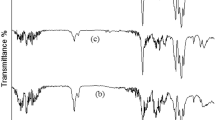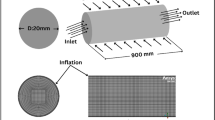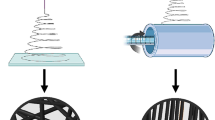Abstract
In this work, we present the preparation, characterization, and 3D printing of highly conductive, soft, and functional nanocomposite polymers. The prepared nanocomposite is a polymeric system that consists of poly (ionic liquid) (PIL), polymethylmethacrylate (PMMA), and multiwalled carbon nanotubes (MWCNTs) as fillers and an ionic liquid (IL) that acts as a plasticizer and dopant for the MWCNTs. The nanocomposites exhibited variable mechanical (strain at break: 50–250%) and conductive properties depending on their composition, and the highest conductivity of 520 Sm−1 was attained with 15 wt.% MWCNT loading owing to the well-defined morphology of the MWCNTs revealed by SEM. The thermal properties of the nanocomposites were measured by thermogravimetric analysis (TGA), differential scanning calorimetry (DSC), and dynamic mechanical analysis (DMA). The results revealed high thermal stability up to 340 °C regardless of the composition and a variable transition temperature dependent on the MWCNT, IL, and polymeric contents. Finally, the conditions for 3D printing were optimized, and as a proof of concept, we demonstrated the fabrication of a flexible, 3D-printed circuit, which can be bent and twisted without damaging the circuit.
Similar content being viewed by others
Log in or create a free account to read this content
Gain free access to this article, as well as selected content from this journal and more on nature.com
or
References
Kalsoom U, Nesterenko PN, Paull B. Recent developments in 3D printable composite materials. RSC Adv. 2016;6:60355–71.
Gross BB, Erkal JL, Lockwood SY, Chen C, Spence DM. Evaluation of 3D printing and its potential imapct on biotechnology and chemical science. Anal Chem. 2014;86:3240–53.
Muroi H, Hidema R, Gong J, Furukawa H. Development of optical 3d gel printer for fabricating free-form soft & wet industrial materials and evaluation of printed double-network gels. J Solid Mech Mater Eng. 2013;7:163–8.
Ahmed K, Naga N, Kawakami M, Furukawa H. Extremely soft, conductive, and transparent ionic gels by 3D optical printing. Macromol Chem Phys. 2018; 1800216. https://doi.org/10.1002/macp.201800216.
Shiblee MNI, Ahmed K, Khosla A, Kawakami M, Furukawa H. 3D printing of shape memory hydrogels with tunable mechanical properties. Soft Matter. 2018;14:7809–17.
Pham DT, Gault RS. A comparison of rapid prototyping technologies. Int J Mach Tools Manuf. 1998;38:1257–87.
Guo S, Gosselin F, Guerin N, Lanouette A, Heuzey MC, Therriault MC. Solvent-cast three-dimensional printing of multifunctional microsystems. Small. 2013;9:4118–22.
Farahani R, Lebel L, Therriault D. Processing parameters investigation for the fabrication of self-supported and freeform polymeric microstructures using ultraviolet-assisted three-dimensional printing. J Micromech Microeng. 2014;24:055020.
Lebel LL, Aissa B, Khakani MAE, Therriault D. Ultraviolet-assisted direct-write fabrication of carbon nanotube/polymer nanocomposite microcoils. Adv Mater. 2010;22:592–6.
Wei X, Li D, Jiang W, Gu Z, Wang X, Zang Z, et al. 3D printable graphene composite. Sci Rep. 2015;5:11181:1-7
Guo S, Qiu K, Meng F, Park SH, Mcalpine MC. 3d printed stretchable tactile sensors. Adv Mater. 2017;29:1701218.
Muth JT, Vogt DM, Truby RL, Mengüç Y, Kolesky DB, Wood RJ, et al. Embedded 3D printing of strain sensors within highly stretchable elastomers. Adv Mater. 2014;26:6307–12.
Guo S, Yang X, Heuzey M, Therriault D. 3D printing of a multifunctional nanocomposite helical liquid sensor. Nanoscale. 2015;7:6451–6.
Farahani RD, Chizari K, Therriault D. Three-dimensional printing of freeform helical microstructures: a review. Nanoscale. 2014;6:10470–85.
Postiglione G, Natale G, Griffini G, Levi M, Turri S. Conductive 3D microstructures by direct 3D printing of polymer/carbon nanotube nanocomposites via liquid deposition modeling. Compos Part A. 2015;76:110–4.
Fukushima T, Kosaka A, Ishimura Y, Yamamoto T, Takigawa T, Ishii N, et al. Molecular ordering of organic molten salts triggered by single-walled carbon nanotubes. Science. 2003;300:2072–4.
Fukushima T, Aida T. Ionic liquids for soft functional materials with carbon nanotubes. Chem Eur J. 2007;13:5048–58.
Polo-Luque ML, Simonet BM, Valcárcel M. Functionalization and dispersion of carbon nanotubes in ionic liquids. TrAC Trends Anal Chem. 2013;47:99–110.
Polo-Luque ML, Simonet BM, Valcárcel M. Solid phase extraction-capillary electrophoresis determination of sulphonamide residues in milk samples by use of C18-carbon nanotubes as hybrid sorbent materials. Analyst . 2013;138:3786–91.
Yu P, Zhou H, Zhu N, Lin Y, Mao LA. A facile approach to construction of a stable water-miscible ionic liquid/electrolyte interface with interactions between imidazolium moiety and carbon nanotubes. Electrochem Commun. 2009;11:1393–6.
Liping Z, Yongjin L, Xiaojun C, Jichun Y, Wenyong D. Multifunctional role of an ionic liquid in melt-blended poly(methyl methacrylate)/multi-walled carbon nanotube nanocomposites. Nanotechnology. 2012;23:255702.
Holbrey JD, Seddon KR. Ionic Liquids. Clean Prod Process. 1999;1:223.
Seddon KR. Ionic liquids: a taste of the future. Nat Mater. 2003;2:363–5.
Sugino T, Kiyohara K, Takeuchi I, Mukai K, Asaka K. Actuator properties of the complexes composed by carbon nanotube and ionic liquid: the effects of additives. Sens Actuators B. 2009;141:179–86.
Terasawa N, Takeuchi I, Matsumoto H, Mukai K, Asaka K. High performance polymer actuator based on carbon nanotube-ionic liquid: effect of ionic liquid. Sens Actuators B. 2011;156:539–45.
Nishimura N, Ohno H. 15th anniversary of polymerized ionic liquids. Polym (Guildf). 2014;55:3289–97.
Meyer F, Raquez JM, Coulembier O, Winter JD, Gerbaux P, Dubois P. Imidazolium end functionalized poly(L-lactide) for efficient carbon nanotube dispersion. Chem Comm. 2010;46:5527–9.
Marcilla R, Curri ML, Cozzoli PD, Martinez MT, Loinaz I, Grande H, et al. Nano-objects on a round trip from water to organics in a polymeric ionic liquid vehicle. Small. 2006;2:507–12.
Liu L, Zheng Z, Gu C, Wang X. The poly (urethane-ionic liquid)/multi-walledcarbon nanotubes composites. Compos Sci Technol. 2010;70:1697–703.
Fukushima T, Kosaka A, Yamamoto Y, Aimiya T, Notazawa S, Takigawa T, et al. Dramatic effect of dispersed carbon nanotubes on the mechanical and electroconductive properties of polymers derived from ionic liquids. Small. 2006;2:554–60.
Bellayer S, Gilman JW, Eidelman N, Bourbigot S, Flambard X, Fox DM, et al. Preparation of homogeneously dispersed multiwalled carbon nanotube/polystyrene nanocomposites via melt extrusion using trialkyl imidazolium compatibilizer. Adv Funct Mater. 2005;15:910–6.
Shim Y, Kim HJ. Solvation of carbon nanotubes in a room-temperature ionic liquid. ACS Nano. 2009;3:1693–702.
Wang JY, Chu HB, Li Y. Why single walled carbon nanotubes disperse in imidazolium-based ionic liquids. ACS Nano. 2008;2:2540–6.
Na S, Singh VK, Singh RK. Development of ion conducting polymer gel electrolyte membranes based on polymer PVdF-HFP, BMIMTFSI ionic liquid and the Li-salt with improved electrical, thermal and structural properties. J Mater Chem C. 2015;3:7305–18.
Roy A, Dutta B, Bhattacharya S. Electroactive phase nucleation and non-isothermal crystallization kinetics study in [DEMM][TFSI] ionic liquid incorporated P (VDF-HFP) co-polymer membranes. J Mater Sci. 2016;51:7814–30.
Chen X, Zhao J, Zhang J, Qiu L, Xu D, Zhang H, et al. Bis-imidazolium based poly(ionic liquid) electrolytes for quasi-solid-state dye-sensitized solar cells. J Mater Chem. 2012;22:18018–24.
Leones R, Costa CM, Machado AV, Esperanc JMSS, Silva MM, Lanceros-Mendez S. Development of solid polymer electrolytes based on poly (vinylidene fluoride-trifluoroethylene) and the [N1112 (OH)][NTf2] ionic liquid for energy storage applications. Solid State Ion. 2013;253:143–50.
Stefanescu EA, Tan X, Lin Z, Bowler N, Kessler MR. Multifunctional PMMA-Ceramic Composites as Structural Dielectrics. Polym (Guildf). 2010;51:5823–32.
Thakur VK, Vennerberg D, Madboulybc SA, Kessler MR. Bio-inspired green surface functionalization of PMMA for multifunctional capacitors. RSC Adv. 2014;4:6677–84.
Xu J, Lv X, Li J, Li Y, Shen L, Zhou H, et al. Simultaneous adsorption and dechlorination of 2,4-dichlorophenol by Pd/Fe nanoparticles with multi-walled carbon nanotube support. J Hazard Mater. 2012;225-6:36–45.
Abdel-Ghani NT, El-Chaghaby GA, Helal FS. Individual and competitive adsorption of phenol and nickel onto multiwalled carbon nanotubes. J Adv Res. 2015;6:405–15.
Ramesh S, Liew C, Ramesh K. Evaluation and investigation on the effect of ionic liquid onto PMMA-PVC gel polymer blend electrolytes. J Non-Cryst Solids. 2011;357:2132–8.
Zhang H, Wang ZG, Zhang ZN, Wu J, Zhang J, He HS. Regenerated cellulose/multiwalled-carbon-nanotube composite fibers with enhanced mechanical properties prepared with the ionic liquid1-allyl-3-methylimidazolium chloride. Adv Mater. 2007;19:698–704.
Mandal A, Nandi AK. Ionic liquid integrated multiwalled carbon nanotube in a poly (vinylidene fluoride) matrix: formation of a piezoelectric β-polymorph with significant reinforcement and conductivity improvement. ACS Appl Mater Interfaces. 2013;5:747–60.
Acknowledgements
This study was partly supported by the Grant-in-Aid for Scientific Research (Category A, Project No. 17H01224, etc.) from the Japan Society for the Promotion of Science (JSPS), the Centre Of Innovation (COI) program from the Japan Science and Technology Agency (JST), the Strategic Innovation Creation Project (SIP) from the New Energy and Industrial Technology Development Organization (NEDO) of Japan, and the Program on Open Innovation Platform with Enterprises, Research Institute and Academia (OPERA) from the JST. Ahmed K. is supported by the JSPS Fellowship for young scientists in the DC1 category. Authors acknowledge Prof. Tomoya Higashihara`s support for the access to the TGA, DSC, and DMA measurement techniques.
Author information
Authors and Affiliations
Corresponding author
Ethics declarations
Conflict of interest
The authors declare that they have no conflict of interest.
Additional information
Publisher’s note: Springer Nature remains neutral with regard to jurisdictional claims in published maps and institutional affiliations.
Supplementary information
Rights and permissions
About this article
Cite this article
Ahmed, K., Kawakami, M., Khosla, A. et al. Soft, conductive nanocomposites based on ionic liquids/carbon nanotubes for 3D printing of flexible electronic devices. Polym J 51, 511–521 (2019). https://doi.org/10.1038/s41428-018-0166-z
Received:
Revised:
Accepted:
Published:
Issue date:
DOI: https://doi.org/10.1038/s41428-018-0166-z
This article is cited by
-
Progress in flexible and rigid sensors for highly sensitive detection of heavy metal ions: innovations in material design, fabrication techniques, and real-world applications
Frontiers of Materials Science (2025)
-
Characterization of 3D printed multi-material soft pneumatic actuator
International Journal of Intelligent Robotics and Applications (2025)
-
Bioresorbable poly(lactic acid) and organic quantum dot-based nanocomposites: luminescent scaffolds for enhanced osteogenesis and real-time monitoring
Journal of Nanostructure in Chemistry (2022)
-
A low-cost and high-value reinforcing filler for styrene butadiene rubber fabricated by a pneumatic separation technique from coal gasification fine slag
Polymer Journal (2020)



